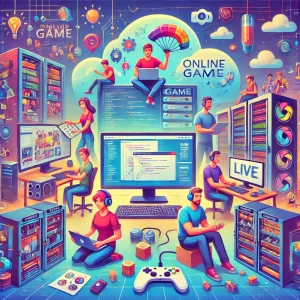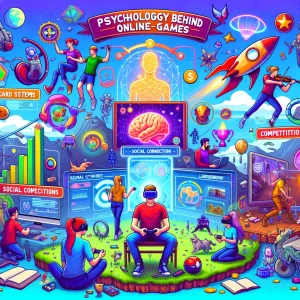Introduction
Online gaming has come a long way since its inception. What began as simple text-based adventures has transformed into vast, immersive virtual worlds where millions of players can interact simultaneously. This evolution reflects technological advancements, shifts in player preferences, and the growing importance of social interaction in gaming. Our website brings you an in-depth look at how online gaming has evolved and what the future holds.
The Early Days: Text-Based Adventures
In the late 1970s and early 1980s, online gaming was in its infancy. Games like Colossal Cave Adventure and Zork offered players the chance to explore worlds through text commands. These games relied heavily on imagination, as players typed commands like “go north” or “pick up sword” to navigate through intricate storylines.
Despite their simplicity, text-based games laid the foundation for online multiplayer experiences. MUDs (Multi-User Dungeons) emerged soon after, allowing multiple players to explore and interact within the same text-based world. These early online communities set the stage for the social aspects that define modern gaming.
The Rise of Graphical Games
The 1990s marked a significant turning point with the introduction of graphical interfaces. Games like Ultima Online and EverQuest brought virtual worlds to life with visuals, making them more accessible to a broader audience. Players could now see their avatars, interact with colorful environments, and engage in complex quests.
This era also saw the birth of MMORPGs (Massively Multiplayer Online Role-Playing Games), where thousands of players could coexist in expansive digital realms. The social component of gaming flourished as players formed guilds, collaborated on missions, and even developed in-game economies.
The 2000s: Expanding Horizons
As internet connectivity improved, so did online gaming experiences. The 2000s introduced games like World of Warcraft, which set new standards for player engagement and content richness. With regular updates, expansive lore, and detailed graphics, these games kept players invested for years.
This period also witnessed the rise of online console gaming. Platforms like Xbox Live and PlayStation Network made it possible for console gamers to connect, compete, and collaborate globally. Online multiplayer modes became a staple feature, turning games like Halo and Call of Duty into global phenomena.
The Advent of Mobile and Casual Gaming
The proliferation of smartphones in the 2010s revolutionized the gaming industry once again. Games like Clash of Clans and Pokémon GO brought online gaming to the masses, allowing players to engage anytime, anywhere. These games introduced new mechanics, such as augmented reality (AR) and location-based gaming, further blurring the lines between virtual and real-world experiences.
Mobile gaming’s accessibility and variety attracted a diverse audience, expanding the gaming community beyond traditional demographics. Casual games like Candy Crush became cultural staples, proving that online gaming was no longer just for hardcore enthusiasts.
Virtual Reality and the Future of Immersion
Today, the gaming industry is embracing technologies like Virtual Reality (VR) and Augmented Reality (AR) to push the boundaries of immersion. Devices like the Oculus Rift and PlayStation VR offer players fully immersive experiences, transporting them into breathtaking virtual landscapes.
Games like Beat Saber and Half-Life: Alyx showcase the potential of VR, providing players with unprecedented levels of interaction and engagement. As technology continues to evolve, we can expect even more realistic environments, advanced AI-driven characters, and seamless integration of physical and virtual realities.
The Social Aspect of Modern Gaming
One of the most significant changes in online gaming is the emphasis on social interaction. Platforms like Twitch and Discord have transformed how players connect, stream, and communicate. Gaming is no longer just about playing; it’s about sharing experiences, building communities, and even pursuing careers through content creation.
Esports has also emerged as a major industry, with professional players competing in tournaments with millions of viewers and substantial prize pools. This social evolution highlights gaming’s role as both entertainment and a means of global connection.
Looking Ahead: What’s Next for Online Gaming?
The future of online gaming promises exciting developments. Cloud gaming services like Google Stadia and Xbox Cloud Gaming aim to make high-quality games more accessible, eliminating the need for expensive hardware. Advances in AI and machine learning are set to create more adaptive and personalized gaming experiences.
Moreover, the concept of the “metaverse”—a fully interconnected virtual universe—is gaining traction. Companies like Meta (formerly Facebook) are investing heavily in creating expansive digital ecosystems where gaming, socializing, and commerce converge.
Conclusion
From humble text-based adventures to sprawling virtual worlds, online gaming has undergone a remarkable transformation. It has evolved from a niche hobby into a global phenomenon that transcends age, geography, and culture. As technology continues to advance, the possibilities for online gaming are virtually limitless.
Our website remains your go-to source for the latest news, insights, and tips on online gaming. Stay connected as we explore the future of this dynamic and ever-changing industry.


